Blackland Conservation and Utilization, Carbon Storage and Ecological Risk in Green Space: A Case Study from Heilongjiang Province in China
Abstract
:1. Introduction
2. Materials and Methods
2.1. Study Area and Data
2.2. Simulation and Forecasting of Land Use Based on the CA–Markov Model
2.3. Green Space Evolution Defined
2.4. Carbon Storage Assessment Based on InVEST Model
2.5. Landscape Ecological Risk Assessment Model
2.6. Coupling Coordination Degree Model
2.7. Bivariate Spatial Autocorrelation Model
3. Results
3.1. Potential Impact of Black Land Conservation and Utilization Policies on the Dynamics of Green Space
3.2. Potential Impacts of Blackland Conservation and Utilization Policies on Carbon Storage and Landscape Ecological Risks in Green Space
3.2.1. Potential Impact on Carbon Storage in Green Space
3.2.2. Potential Impact on the Ecological Risk of the Landscape in Green Spaces
3.3. Coupled Coordination Analysis of Carbon Storage and Landscape Ecological Risk in Green Space
3.4. Correlation Analysis of Carbon Storage Changes and Landscape Ecological Risk Changes in the Evolution of Green Space
3.4.1. Quantitative Correlations
3.4.2. Spatial Correlations
4. Discussion
4.1. Potential Impacts of Land Use Policies on Carbon Storage and Landscape Ecological Risks in Green Spaces and Their Causes
4.2. Relationship between Carbon Storage and Landscape Ecological Risk in Green Space in the Future Period
4.3. Implications for Black Land Conservation and Utilization Plan and Green Space System Planning of Territorial Spatial in the Future Stage
4.4. Limitations and Prospects
5. Conclusions
- (1)
- From 2020 to 2030, the area of green space in HLJP will exhibit a decreasing trend; however, the BCU measure will minimize the loss of 8492 km2 of green area.
- (2)
- In 2030, compared to the NP scenario, the BCU scenario will eliminate the 107.44 × 106 t CS loss caused by the evolution of the green area. The BCU scenario can successfully reduce the total LER level in green space. The green space exchange condition influences, to some extent, the spatial pattern of CS change and LER change.
- (3)
- In 2030, under the BCU scenario, the interdependence between CS and LER is greater than under the NP scenario, but the degree of coupling coordination is slightly lower, and mainly reduces the coupling coordination in the southeast of HLJP.
- (4)
- From 2020 to 2030, there is a significant negative correlation between changes in CS and LER in the green space expansion state, while the two variables are positively correlated in the exchange and loss states. The BCU scenario will considerably increase the size of the H–L sectors, and Heihe City and Jiamusi City are ideal regions for future green spatial evolution for carbon sequestration advantages and risk management.
Author Contributions
Funding
Data Availability Statement
Acknowledgments
Conflicts of Interest
References
- Nyamari, N.; Cabral, P. Impact of land cover changes on carbon stock trends in Kenya for spatial implementation of REDD+ policy. Appl. Geogr. 2021, 133, 102479. [Google Scholar] [CrossRef]
- Bamminger, C.; Poll, C.; Marhan, S. Offsetting global warming-induced elevated greenhouse gas emissions from an arable soil by biochar application. Glob. Change Biol. 2018, 24, e318–e334. [Google Scholar] [CrossRef] [PubMed]
- Laporta, L.; Domingos, T.; Marta-Pedroso, C. It’s a keeper: Valuing the carbon storage service of Agroforestry ecosystems in the context of CAP Eco-Schemes. Land Use Policy 2021, 109, 105712. [Google Scholar] [CrossRef]
- Reang, D.; Hazarika, A.; Sileshi, G.W.; Pandey, R.; Das, A.K.; Nath, A.J. Assessing tree diversity and carbon storage during land use transitioning from shifting cultivation to indigenous agroforestry systems: Implications for REDD+ initiatives. J. Environ. Manag. 2021, 298, 113470. [Google Scholar] [CrossRef]
- Cai, W.; Peng, W. Exploring Spatiotemporal Variation of Carbon Storage Driven by Land Use Policy in the Yangtze River Delta Region. Land 2021, 10, 1120. [Google Scholar] [CrossRef]
- Wang, J.; Cao, Y.; Fang, X.; Li, G.; Cao, Y. Identification of the trade-offs/synergies between rural landscape services in a spatially explicit way for sustainable rural development. J. Environ. Manag. 2021, 300, 113706. [Google Scholar] [CrossRef]
- Wang, B.; Ding, M.; Li, S.; Liu, L.; Ai, J. Assessment of landscape ecological risk for a cross-border basin: A case study of the Koshi River Basin, central Himalayas. Ecol. Indic. 2020, 117, 106621. [Google Scholar] [CrossRef]
- Gómez-Baggethun, E.; Barton, D.N. Classifying and valuing ecosystem services for urban planning. Ecol. Econ. 2013, 86, 235–245. [Google Scholar] [CrossRef]
- Li, K.; Cao, J.; Adamowski, J.F.; Biswas, A.; Zhou, J.; Liu, Y.; Zhang, Y.; Liu, C.; Dong, X.; Qin, Y. Assessing the effects of ecological engineering on spatiotemporal dynamics of carbon storage from 2000 to 2016 in the Loess Plateau area using the InVEST model: A case study in Huining County, China. Environ. Dev. 2021, 39, 100641. [Google Scholar] [CrossRef]
- Peng, J.; Dang, W.; Liu, Y.; Zong, M.; Hu, X. Review on landscape ecological risk assessment. Acta Geogr. Sin. 2015, 70, 664–677. [Google Scholar]
- Hunsaker, C.T.; Graham, R.L.; Suter, G.W.; O’Neill, R.V.; Barnthouse, L.W.; Gardner, R.H. Assessing ecological risk on a regional scale. Environ. Manag. 1990, 14, 325–332. [Google Scholar] [CrossRef]
- Zhang, D.; Jing, P.; Sun, P.; Ren, H.; Ai, Z. The non-significant correlation between landscape ecological risk and ecosystem services in Xi’an Metropolitan Area, China. Ecol. Indic. 2022, 141, 109118. [Google Scholar] [CrossRef]
- Xie, L.; Bai, Y.; Che, L.; Qiao, F.; Sun, S.; Yang, X. Construction of ecological zone based on value-risk ecological function area in the Upper Yellow River. J. Nat. Resour. 2021, 36, 196. [Google Scholar] [CrossRef]
- Fu, M.; Tang, W.; Liu, W.; He, Y.; Zhu, Y. Ecological risk assessment and spatial identification of ecological restoration from the ecosystem service perspective: A case study in source region of Yangtze River. Acta Ecol. Sin. 2021, 41, 3846–3855. [Google Scholar]
- Watanabe, M.D.B.; Ortega, E. Dynamic emergy accounting of water and carbon ecosystem services: A model to simulate the impacts of land-use change. Ecol. Model. 2014, 271, 113–131. [Google Scholar] [CrossRef]
- Zhang, S.; Zhong, Q.; Cheng, D.; Xu, C.; Chang, Y.; Lin, Y.; Li, B. Coupling Coordination Analysis and Prediction of Landscape Ecological Risks and Ecosystem Services in the Min River Basin. Land 2022, 11, 222. [Google Scholar] [CrossRef]
- Li, J.; Gao, M. Spatiotemporal evolution and correlation analysis of ecosystem service values and ecological risk in Binzhou. Acta Ecol. Sin. 2019, 39, 7815–7827. [Google Scholar]
- Jia, Y.; Tang, X.; Liu, W. Spatial–Temporal Evolution and Correlation Analysis of Ecosystem Service Value and Landscape Ecological Risk in Wuhu City. Sustainability 2020, 12, 2803. [Google Scholar] [CrossRef]
- Jia, Y.; Tang, X.; Ren, Y. Spatial-temporal evolution and correlation analyses of ecosystem service values and landscape ecological risks in Anhui section of the Yangtze River basin. J. Nanjing For. Univ. Nat. Sci. Ed. 2022, 46, 31–40. [Google Scholar]
- Jin, T.; Zhang, Y.; Zhu, Y.; Gong, J.; Yan, L. Spatiotemporal variations of ecosystem service values and landscape ecological risk and their correlation in forest area of Loess Plateau, China: A case study of Ziwuling region. Chin. J. Appl. Ecol. 2021, 32, 1623–1632. [Google Scholar]
- Gong, J.; Cao, E.; Xie, Y.; Cai, C.; Li, H.; Yan, L. Integrating ecosystem services and landscape ecological risk into adaptive management: Insights from a western mountain-basin area, China. J. Environ. Manag. 2021, 14, 111817. [Google Scholar] [CrossRef] [PubMed]
- Abass, K.; Afriyie, K.; Gyasi, R.M. From green to grey: The dynamics of land use/land cover change in urban Ghana. Landsc. Res. 2019, 44, 909–921. [Google Scholar] [CrossRef]
- Baul, T.K.; Peuly, T.A.; Nandi, R.; Schmidt, L.H.; Karmakar, S. Carbon stocks of homestead forests have a mitigation potential to climate change in Bangladesh. Sci. Rep. 2021, 11, 9254. [Google Scholar] [CrossRef] [PubMed]
- Lin, Z.; Chao, L.; Wu, C.; Hong, W.; Hong, T.; Hu, X. Spatial analysis of carbon storage density of mid-subtropical forests using geostatistics: A case study in Jiangle County, southeast China. Acta Geochim. 2018, 37, 90–101. [Google Scholar] [CrossRef]
- Zhang, L.; Zhou, G.; Ji, Y.; Bai, Y. Spatiotemporal dynamic simulation of grassland carbon storage in China. Sci. China Earth Sci. 2016, 59, 1946–1958. [Google Scholar] [CrossRef]
- Wang, S.; Zhao, C.; Chen, X.; Liu, D. Remote sensing-based green space evolution in Tangshan and its influence on heat island effect. Remote Sens. Nat. Resour. 2022, 34, 168–175. [Google Scholar]
- Han, X.; Li, N. Research Progress of Black Soil in Northeast China. Sci. Geogr. Sin. 2018, 38, 1032–1041. [Google Scholar]
- Rudd, L.; Kulshreshtha, S.; Belcher, K.; Amichev, B. Carbon life cycle assessment of shelterbelts in Saskatchewan, Canada. J. Environ. Manag. 2021, 297, 113400. [Google Scholar] [CrossRef]
- Xu, S. Temporal and Spatial Characteristics of the Change of Cultivated Land Resources in the Black Soil Region of Heilongjiang Province (China). Sustainability 2018, 11, 38. [Google Scholar] [CrossRef]
- Hao, C.L.; Xiao, W.H.; Dang, X.F.; Shi, M.; He, D.W. Study on Soil and Water Loss of Black Soils in Northeast China. AMR 2014, 1010–1012, 1153–1157. [Google Scholar] [CrossRef]
- Zhang, S.; Qu, F.; Wang, X.; Xiao, Z.; Hao, X.; Wang, L. Freeze-thaw cycles changes soil nitrogen in a Mollisol sloping field in Northeast China. Nutr. Cycl. Agroecosyst. 2020, 116, 345–364. [Google Scholar] [CrossRef]
- Xu, J.; Li, H.; Liu, X.; Hu, W.; Yang, Q.; Hao, Y.; Zhen, H.; Zhang, X. Gully Erosion Induced by Snowmelt in Northeast China: A Case Study. Sustainability 2019, 11, 2088. [Google Scholar] [CrossRef]
- Han, R.; Li, J.; Guo, Z. Optimal quota in China’s energy capping policy in 2030 with renewable targets and sectoral heterogeneity. Energy 2022, 239, 121971. [Google Scholar] [CrossRef]
- Mansour, S.; Al-Belushi, M.; Al-Awadhi, T. Monitoring land use and land cover changes in the mountainous cities of Oman using GIS and CA-Markov modelling techniques. Land Use Policy 2020, 91, 104414. [Google Scholar] [CrossRef]
- Gao, X.; Wang, J.; Li, C.; Shen, W.; Song, Z.; Nie, C.; Zhang, X. Land use change simulation and spatial analysis of ecosystem service value in Shijiazhuang under multi-scenarios. Env. Sci. Pollut. Res. 2021, 28, 31043–31058. [Google Scholar] [CrossRef]
- Gong, W.; Yuan, L.; Fan, W.; Stott, P. Analysis and simulation of land use spatial pattern in Harbin prefecture based on trajectories and cellular automata—Markov modelling. Int. J. Appl. Earth Obs. Geoinf. 2015, 34, 207–216. [Google Scholar] [CrossRef]
- Liu, J.; Liu, M.; Deng, X.; Zhuang, D.; Zhang, Z.; Luo, D. The land use and land cover change database and its relative studies in China. J. Geogr. Sci. 2002, 12, 275–282. [Google Scholar]
- Chen, Y.; Cai, Y.; Tong, C. Temperature effect under the green space evolution based on remote sensing: A case study of Fuzhou, China. Acta Ecol. Sin. 2020, 40, 2439–2449. [Google Scholar]
- Piyathilake, I.D.U.H.; Udayakumara, E.P.N.; Ranaweera, L.V.; Gunatilake, S.K. Modeling predictive assessment of carbon storage using InVEST model in Uva province, Sri Lanka. Model. Earth Syst. Environ. 2022, 8, 2213–2223. [Google Scholar] [CrossRef]
- Lyu, R.; Mi, L.; Zhang, J.; Xu, M.; Li, J. Modeling the effects of urban expansion on regional carbon storage by coupling SLEUTH-3r model and InVEST model. Ecol. Res. 2019, 34, 380–393. [Google Scholar] [CrossRef]
- Li, L.; Song, Y.; Wei, X.; Dong, J. Exploring the impacts of urban growth on carbon storage under integrated spatial regulation: A case study of Wuhan, China. Ecol. Indic. 2020, 111, 106064. [Google Scholar] [CrossRef]
- Wang, C.; Luo, J.; Qing, F.; Tang, Y.; Wang, Y. Analysis of the Driving Force of Spatial and Temporal Differentiation of Carbon Storage in Taihang Mountains Based on InVEST Model. Appl. Sci. 2022, 12, 10662. [Google Scholar] [CrossRef]
- Zhang, C.; Wang, L.; Song, Q.; Chen, X.; Gao, H.; Wang, X. Biomass carbon stocks and dynamics of forests in Heilongjiang Province from 1973 to 2013. China Environ. Sci. 2018, 38, 4678–4686. [Google Scholar]
- Liu, X.; Li, X.; Liang, X.; Shi, H.; Ou, J. Simulating the Change of Terrestrial Carbon Storage in China Based on the FLUS-InVEST Model. Trop. Geogr. 2019, 39, 397–409. [Google Scholar]
- Piao, S.; Fang, J.; He, J.; Xiao, Y. Spatial distribution of grassland biomass in china. Acta Phytoecol. Sin. 2004, 28, 491–498. [Google Scholar]
- Hu, H.; Luo, B.; Wei, S.; Wei, S.; Sun, L.; Luo, S.; Ma, H. Biomass carbon density and carbon sequestration capacity in seven typical forest types of the Xiaoxing’an Mountains, China. Chin. J. Plant Ecol. 2015, 39, 140–158. [Google Scholar]
- Chuai, X.; Huang, X.; Lai, L.; Wang, W.; Peng, J.; Zhao, R. Land use structure optimization based on carbon storage in several regional terrestrial ecosystems across China. Environ. Sci. Policy 2013, 25, 50–61. [Google Scholar] [CrossRef]
- Zhu, Z.; Mei, Z.; Xu, X.; Feng, Y.; Ren, G. Landscape Ecological Risk Assessment Based on Land Use Change in the Yellow River Basin of Shaanxi, China. Int. J. Environ. Res. Public Health 2022, 19, 9547. [Google Scholar] [CrossRef]
- Qiao, F.; Bai, Y.; Xie, L.; Yang, X.; Sun, S. Spatio-Temporal Characteristics of Landscape Ecological Risks in the Ecological Functional Zone of the Upper Yellow River, China. Int. J. Environ. Res. Public Health 2021, 18, 2943. [Google Scholar] [CrossRef]
- Zhu, K.; He, J.; Zhang, L.; Song, D.; Wu, L.; Liu, Y.; Zhang, S. Impact of Future Development Scenario Selection on Landscape Ecological Risk in the Chengdu-Chongqing Economic Zone. Land 2022, 11, 964. [Google Scholar] [CrossRef]
- Ji, Y.; Bai, Z.; Hui, J. Landscape Ecological Risk Assessment Based on LUCC-A Case Study of Chaoyang County, China. Forests 2021, 12, 1157. [Google Scholar] [CrossRef]
- Wang, H.; Liu, X.; Zhao, C.; Chang, Y.; Liu, Y.; Zang, F. Spatial-temporal pattern analysis of landscape ecological risk assessment based on land use/land cover change in Baishuijiang National nature reserve in Gansu Province, China. Ecol. Indic. 2021, 124, 7454. [Google Scholar] [CrossRef]
- Cui, L.; Zhao, Y.; Liu, J.; Han, L.; Ao, Y.; Yin, S. Landscape ecological risk assessment in Qinling Mountain. Geol. J. 2018, 53, 342–351. [Google Scholar] [CrossRef]
- Fan, Q.; Shi, Y.; Song, X.; Li, H.; Sun, W.; Wu, F. Evolution Analysis of the Coupling Coordination of Microclimate and Landscape Ecological Risk Degree in the Xiahuayuan District in Recent 20 Years. Sustainability 2022, 14, 1893. [Google Scholar] [CrossRef]
- Kang, Z.; Zhang, Z.; Wei, H.; Liu, L.; Ning, S.; Zhao, G.; Wang, T.; Tian, H. Landscape ecological risk assessment in Manas River Basin based on land use change. Acta Ecol. Sin. 2020, 40, 6472–6485. [Google Scholar]
- Sun, L.; Song, G. Land Use/Cover Change and Its Landscape Ecological Risk Analysis in the Black Soil Region of Songnen High Plain--A Case Study of Bayan County. Res. Soil Water Conserv. 2012, 19, 148–153, 158. [Google Scholar]
- Hu, Z.; Yang, X.; Yang, J.; Yuan, J.; Zhang, Z. Linking landscape pattern, ecosystem service value, and human well-being in Xishuangbanna, southwest China: Insights from a coupling coordination model. Glob. Ecol. Conserv. 2021, 27, e01583. [Google Scholar] [CrossRef]
- Wang, Y.; Ji, Y.; Yu, H.; Lai, X. Measuring the Relationship between Physical Geographic Features and the Constraints on Ecosystem Services from Urbanization Development. Sustainability 2022, 14, 8149. [Google Scholar] [CrossRef]
- Long, K.; Pijanowski, B.C. Is there a relationship between water scarcity and water use efficiency in China? A national decadal assessment across spatial scales. Land Use Policy 2017, 69, 502–511. [Google Scholar] [CrossRef]
- Yang, J.; Xie, B.; Zhang, D. The Trade-Offs and Synergistic Relationships between Grassland Ecosystem Functions in the Yellow River Basin. Diversity 2021, 13, 505. [Google Scholar] [CrossRef]
- Lahiji, R.N.; Dinan, N.M.; Liaghati, H.; Ghaffarzadeh, H.; Vafaeinejad, A. Scenario-based estimation of catchment carbon storage: Linking multi-objective land allocation with InVEST model in a mixed agriculture-forest landscape. Front. Earth Sci. 2020, 14, 637–646. [Google Scholar] [CrossRef]
- Jiang, W.; Deng, Y.; Tang, Z.; Lei, X.; Chen, Z. Modelling the potential impacts of urban ecosystem changes on carbon storage under different scenarios by linking the CLUE-S and the InVEST models. Ecol. Model. 2017, 345, 30–40. [Google Scholar] [CrossRef]
- Han, J.; Meng, X.; Zhou, X.; Yi, B.; Liu, M.; Xiang, W.-N. A long-term analysis of urbanization process, landscape change, and carbon sources and sinks: A case study in China’s Yangtze River Delta region. J. Clean. Prod. 2017, 141, 1040–1050. [Google Scholar] [CrossRef]
- Zhang, W.; Chang, W.J.; Zhu, Z.C.; Hui, Z. Landscape ecological risk assessment of Chinese coastal cities based on land use change. Appl. Geogr. 2020, 117, 102174. [Google Scholar] [CrossRef]
- Xu, W.; Wang, J.; Zhang, M.; Li, S. Construction of landscape ecological network based on landscape ecological risk assessment in a large-scale opencast coal mine area. J. Clean. Prod. 2021, 286, 125523. [Google Scholar] [CrossRef]
- Cai, H.; Ma, K.; Luo, Y. Geographical Modeling of Spatial Interaction between Built-Up Land Sprawl and Cultivated Landscape Eco-Security under Urbanization Gradient. Sustainability 2019, 11, 5513. [Google Scholar] [CrossRef]
- Shen, J.; Wang, X. Spatial-temporal Changes in Ecological Risk of Land Use before and after Grain-for-Green Policy in Zhengning County, Gansu Province. J. Resour. Ecol. 2013, 4, 36–42. [Google Scholar]
- Bian, J.; Chen, W.; Zeng, J. Ecosystem services, landscape pattern, and landscape ecological risk zoning in China. Environ. Sci. Pollut. Res. 2022. [Google Scholar] [CrossRef]
- Zhu, R.; Chen, S. Spatial relationship between landscape ecological risk and ecosystem service value in Fujian Province, China during 1980–2020. J. Appl. Ecol. 2022, 33, 1599–1607. [Google Scholar] [CrossRef]
- Xu, Y.; Dai, W.; Huang, W.; Huang, K.; Hu, H. Spatiotemporal evolution and correlation analysis of ecosystem service values and ecological risk in Fuzhou central city. Ecol. Sci. 2021, 40, 92–101. [Google Scholar]
- Jiang, W.; Xu, Y.; Li, D.; Bi, S.; Li, Q.; Lu, L. Process and Correlation Between Ecosystem Services Value and Ecological Risk in River Basin-A Case Study at Huaihe River Basin in Anhui Province. Bull. Soil Water Conserv. 2022, 42, 120–130. [Google Scholar]
- Wang, Y.; Yang, Z.; Yu, M.; Lin, R.; Zhu, L.; Bai, F. Integrating Ecosystem Health and Services for Assessing Ecological Risk and its Response to Typical Land-Use Patterns in the Eco-fragile Region, North China. Environ. Manag. 2022, 1–8. [Google Scholar] [CrossRef]
- Wang, X.; Ding, Z.; Zhang, S.; Hou, H.; Chen, Z.; Wu, Q. Spatial–Temporal Multivariate Correlation Analysis of Ecosystem Services and Ecological Risk in Areas of Overlapped Cropland and Coal Resources in the Eastern Plains, China. Land 2023, 12, 74. [Google Scholar] [CrossRef]
- Kang, P.; Chen, W.; Hou, Y.; Li, Y. Linking ecosystem services and ecosystem health to ecological risk assessment: A case study of the Beijing-Tianjin-Hebei urban agglomeration. Sci. Total Environ. 2018, 636, 1442–1454. [Google Scholar] [CrossRef]
- Xie, X.; Fang, B.; Xu, H.; He, S.; Li, X. Study on the coordinated relationship between Urban Land use efficiency and ecosystem health in China. Land Use Policy 2021, 102, 105235. [Google Scholar] [CrossRef]
- Liu, J.; Xu, H.; Wang, Y.; Li, H.; Shen, W. Evaluation of ecological risk and carbon fixation from land use change: A case study of Huanghua City, Hebei Province. Chin. J. Eco-Agric. 2018, 26, 1217–1226. [Google Scholar]
- Jing, X.; Tian, G.; Li, M.; Javeed, S. Research on the Spatial and Temporal Differences of China’s Provincial Carbon Emissions and Ecological Compensation Based on Land Carbon Budget Accounting. Int. J. Environ. Res. Public Health 2021, 18, 2892. [Google Scholar] [CrossRef]
- Fang, H. Changes in Cultivated Land Area and Associated Soil and SOC Losses in Northeastern China: The Role of Land Use Policies. Int. J. Environ. Res. Public Health 2021, 18, 1314. [Google Scholar] [CrossRef]
- Huang, D.; Yi, F.; Wang, S.; Wei, H.; Wang, S. Blue-green space pattern and indicator system in territorial planning. City Plan. Rev. 2022, 46, 18–31. [Google Scholar]
- Xu, J.; Xu, D.; Qu, C. Construction of Ecological Security Pattern and Identification of Ecological Restoration Zones in the City of Changchun, China. Int. J. Environ. Res. Public Health 2023, 20, 289. [Google Scholar] [CrossRef]
- Han, J.; Hu, Z.; Mao, Z.; Li, G.; Liu, S.; Yuan, D.; Guo, J. How to Account for Changes in Carbon Storage from Coal Mining and Reclamation in Eastern China? Taking Yanzhou Coalfield as an Example to Simulate and Estimate. Remote Sens. 2022, 14, 2014. [Google Scholar] [CrossRef]
- Song, Y.; Song, X.; Shao, G. Effects of Green Space Patterns on Urban Thermal Environment at Multiple Spatial–Temporal Scales. Sustainability 2020, 12, 6850. [Google Scholar] [CrossRef]
- Ai, J.; Yu, K.; Zeng, Z.; Yang, L.; Liu, Y.; Liu, J. Assessing the dynamic landscape ecological risk and its driving forces in an island city based on optimal spatial scales: Haitan Island, China. Ecol. Indic. 2022, 137, 108771. [Google Scholar] [CrossRef]
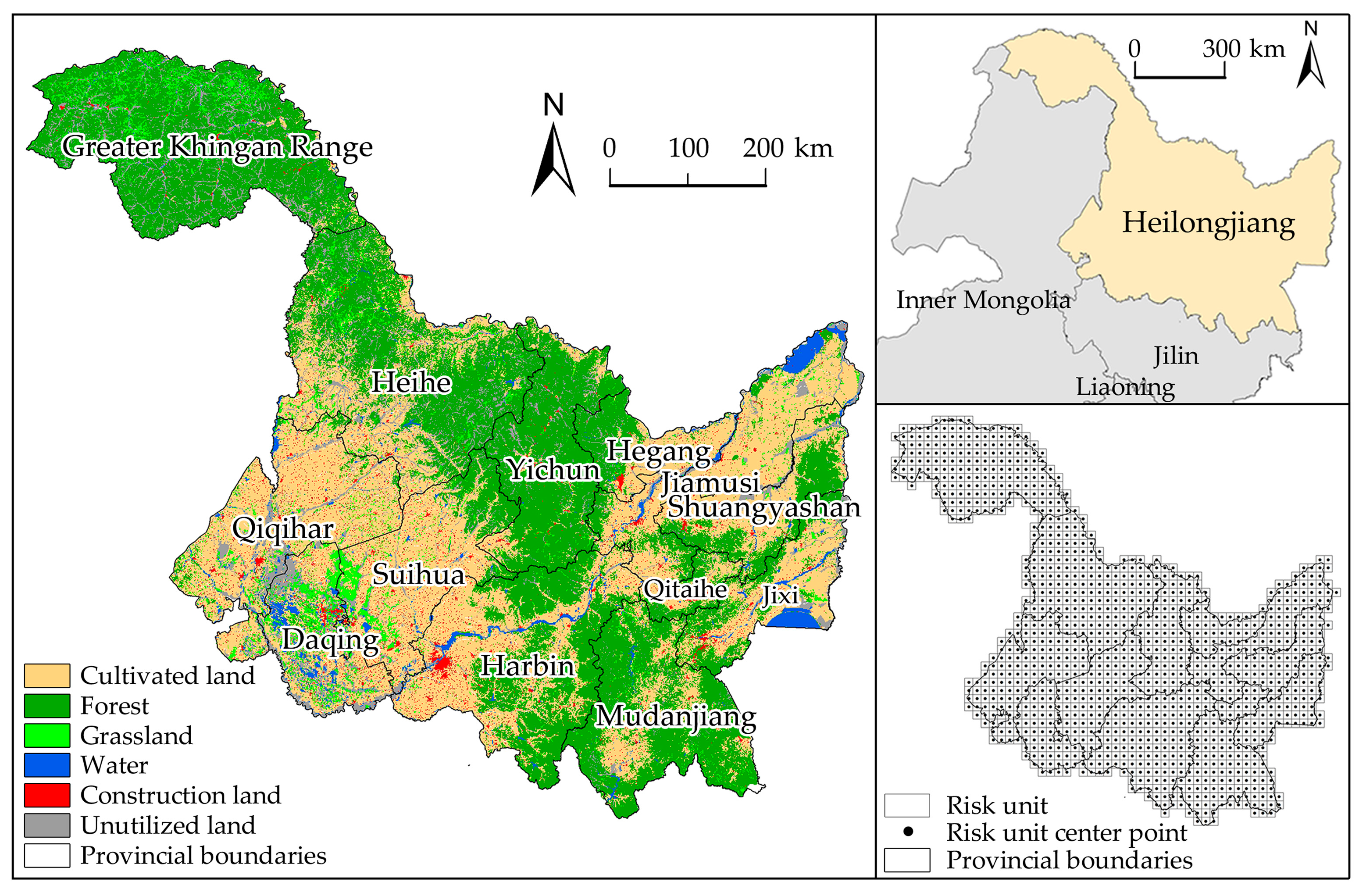
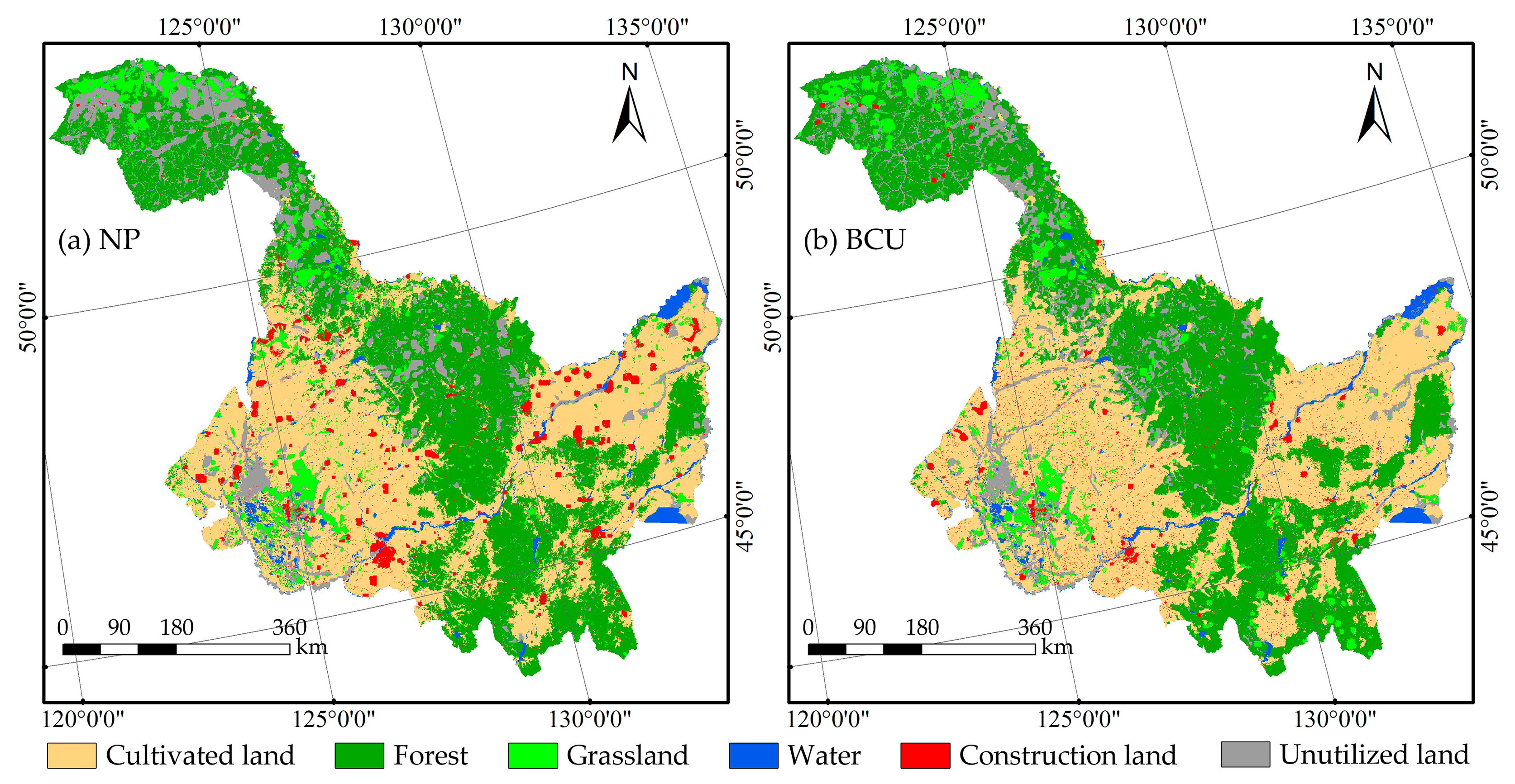
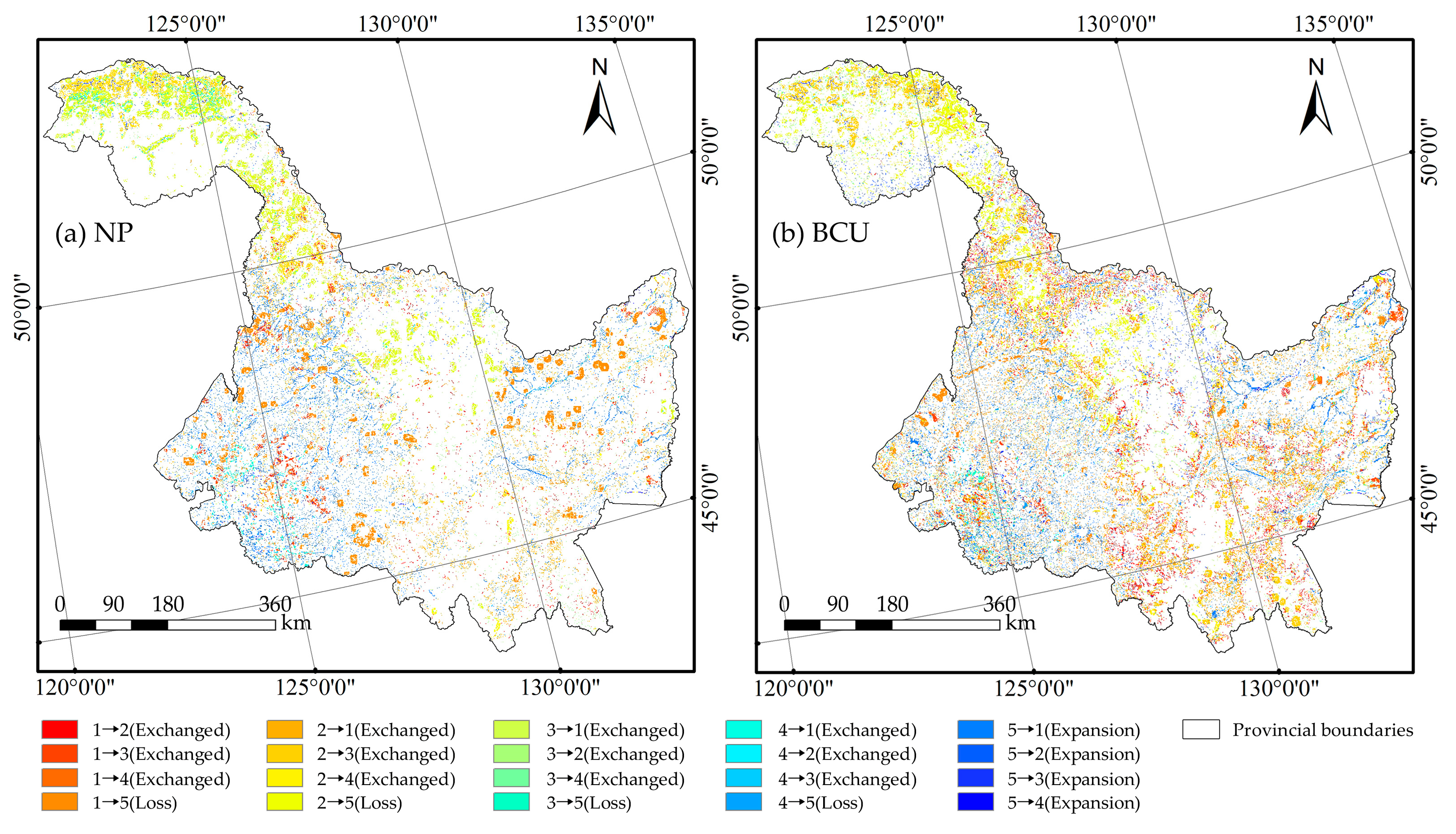



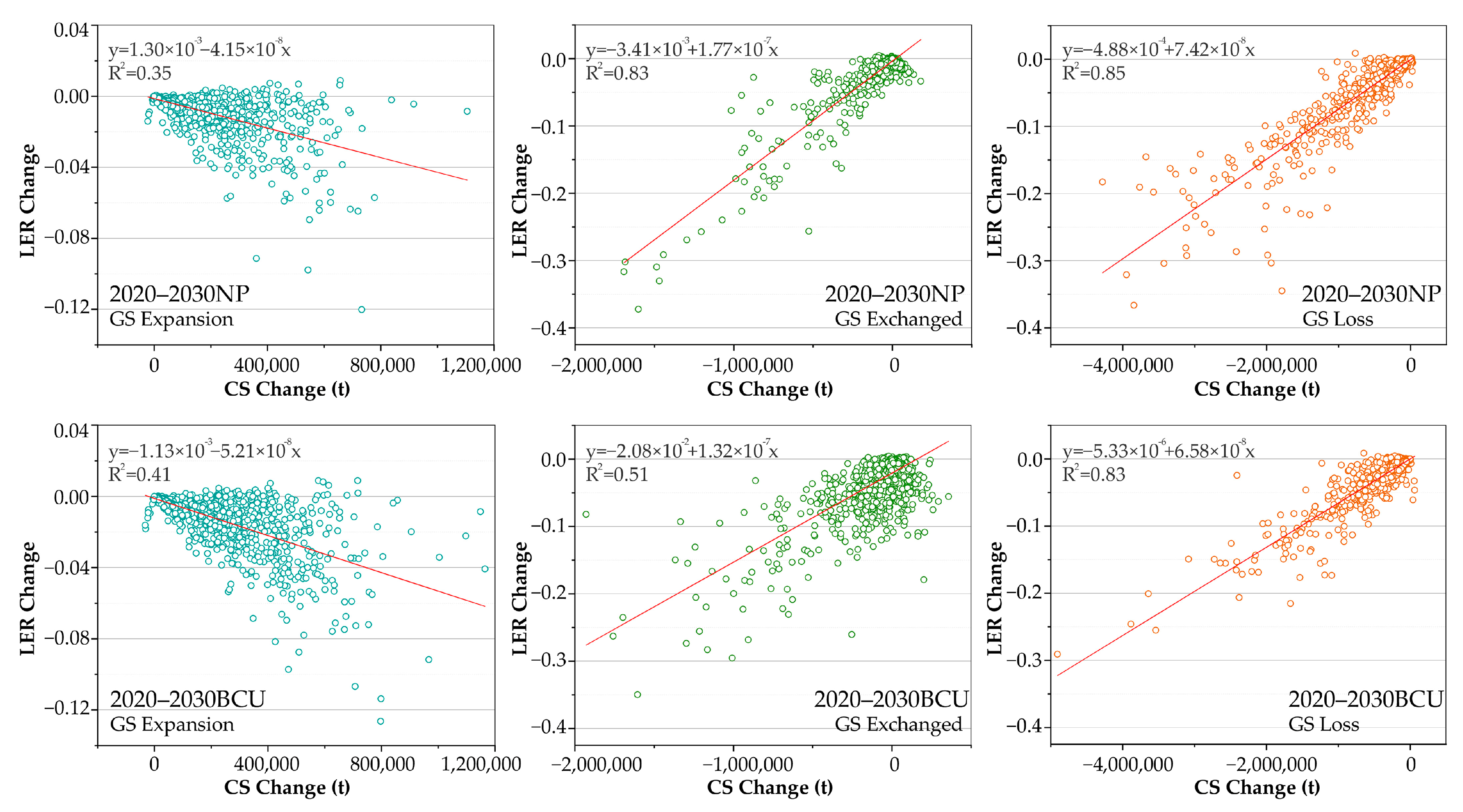
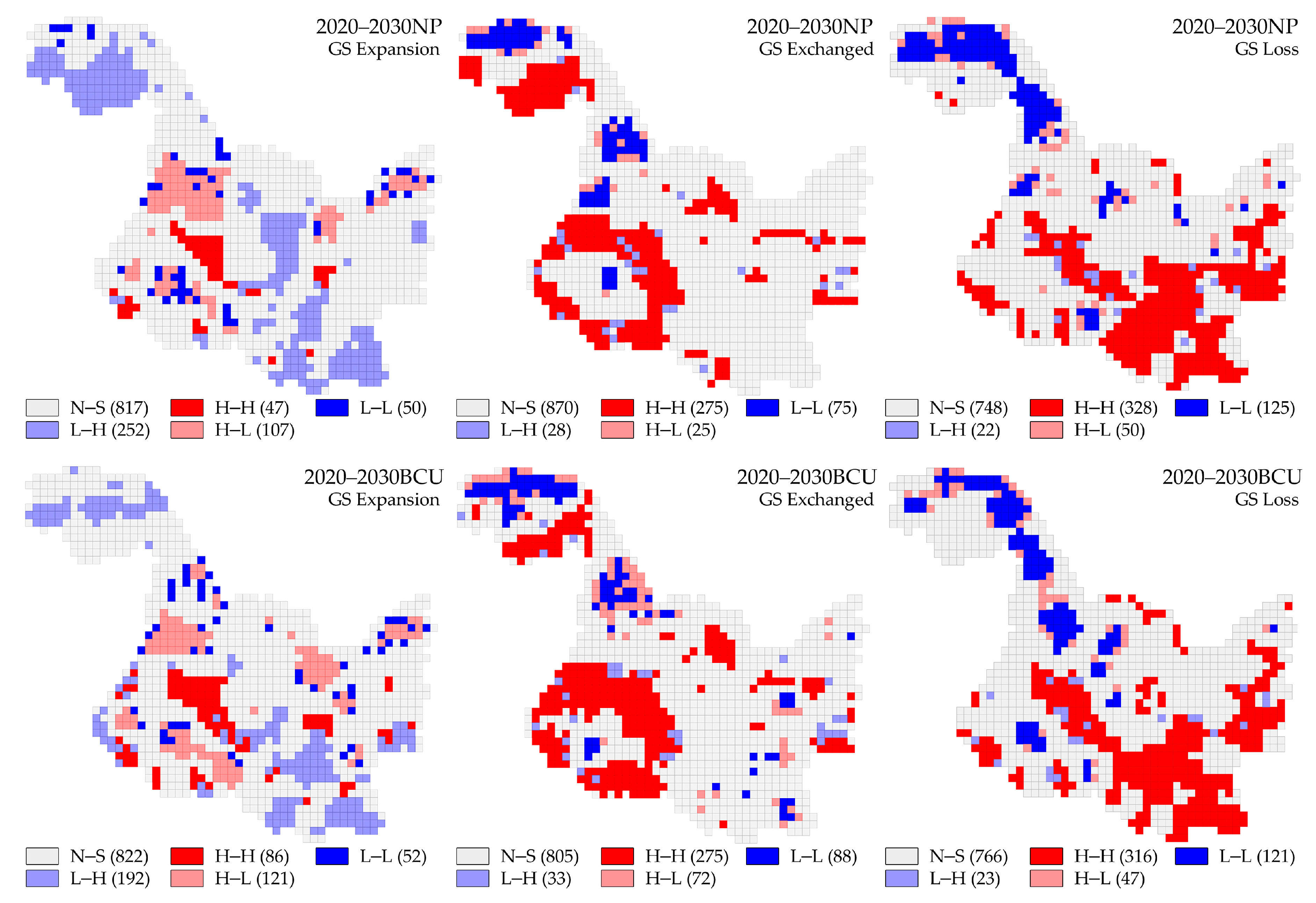
| LULC | C_above | C_below | C_soil | C_dead |
|---|---|---|---|---|
| Cultivated land | 10.1 | 26.8 | 147 | 0 |
| Forest | 11.46 | 31.32 | 173.9 | 2.02 |
| Grassland | 7.96 | 51 | 74.6 | 2.84 |
| Water | 8.72 | 2.21 | 23.01 | 0 |
| Construction land | 8.75 | 4.39 | 27.78 | 1.16 |
| Unutilized land | 10.03 | 0 | 44.79 | 0 |
| Landscape Pattern Index | Calculation Formula | Ecological Meaning |
|---|---|---|
| Landscape fragmentation index Ci | Indicates the degree of spatial fragmentation of the landscape, with a higher value indicating a greater human disturbance of the landscape pattern [48]. | |
| Landscape separation index Si | Indicates the degree of separation between the individual distributions of different patches in a certain landscape type, with greater values indicating a more complex landscape distribution [49]. | |
| Landscape dominance index Ki | This shows the significance of landscape patches, with greater values indicating a more homogeneous landscape type [50]. | |
| Landscape disturbance index Ii | Indicating the degree of loss of several landscape types following a disturbance [51]. | |
| Landscape vulnerability index Ei | Drawing on relevant studies in similar natural environment areas to obtain | Larger numbers indicate more susceptibility to external environmental disturbances [52]. |
| Landscape loss index Ri | Indicating the degree of ecological damage caused by various landscape types as a response to external disturbances [53]. | |
| Landscape vulnerability index ERI | Describe the degree of combined ecological loss across many landscape types, with larger values indicating greater ecological risk [54]. |
| Study Period | GS Expansion | GS Exchanged | GS Loss |
|---|---|---|---|
| Area (km2) | Area (km2) | Area (km2) | |
| 2020–2030 NP | 13,422 | 18,186 | 30,244 |
| 2020–2030 BCU | 19,549 | 41,130 | 27,879 |
| Study Period | CS | LER | C | T | D |
|---|---|---|---|---|---|
| 2020 | 0.690 | 0.813 | 0.997 | 0.751 | 0.865 |
| 2030 NP | 0.651 | 0.759 | 0.997 | 0.705 | 0.838 |
| 2030 BCU | 0.666 | 0.713 | 0.999 | 0.689 | 0.830 |
Disclaimer/Publisher’s Note: The statements, opinions and data contained in all publications are solely those of the individual author(s) and contributor(s) and not of MDPI and/or the editor(s). MDPI and/or the editor(s) disclaim responsibility for any injury to people or property resulting from any ideas, methods, instructions or products referred to in the content. |
© 2023 by the authors. Licensee MDPI, Basel, Switzerland. This article is an open access article distributed under the terms and conditions of the Creative Commons Attribution (CC BY) license (https://creativecommons.org/licenses/by/4.0/).
Share and Cite
Qu, C.; Li, W.; Xu, J.; Shi, S. Blackland Conservation and Utilization, Carbon Storage and Ecological Risk in Green Space: A Case Study from Heilongjiang Province in China. Int. J. Environ. Res. Public Health 2023, 20, 3154. https://doi.org/10.3390/ijerph20043154
Qu C, Li W, Xu J, Shi S. Blackland Conservation and Utilization, Carbon Storage and Ecological Risk in Green Space: A Case Study from Heilongjiang Province in China. International Journal of Environmental Research and Public Health. 2023; 20(4):3154. https://doi.org/10.3390/ijerph20043154
Chicago/Turabian StyleQu, Chen, Wen Li, Jia Xu, and Song Shi. 2023. "Blackland Conservation and Utilization, Carbon Storage and Ecological Risk in Green Space: A Case Study from Heilongjiang Province in China" International Journal of Environmental Research and Public Health 20, no. 4: 3154. https://doi.org/10.3390/ijerph20043154
APA StyleQu, C., Li, W., Xu, J., & Shi, S. (2023). Blackland Conservation and Utilization, Carbon Storage and Ecological Risk in Green Space: A Case Study from Heilongjiang Province in China. International Journal of Environmental Research and Public Health, 20(4), 3154. https://doi.org/10.3390/ijerph20043154






